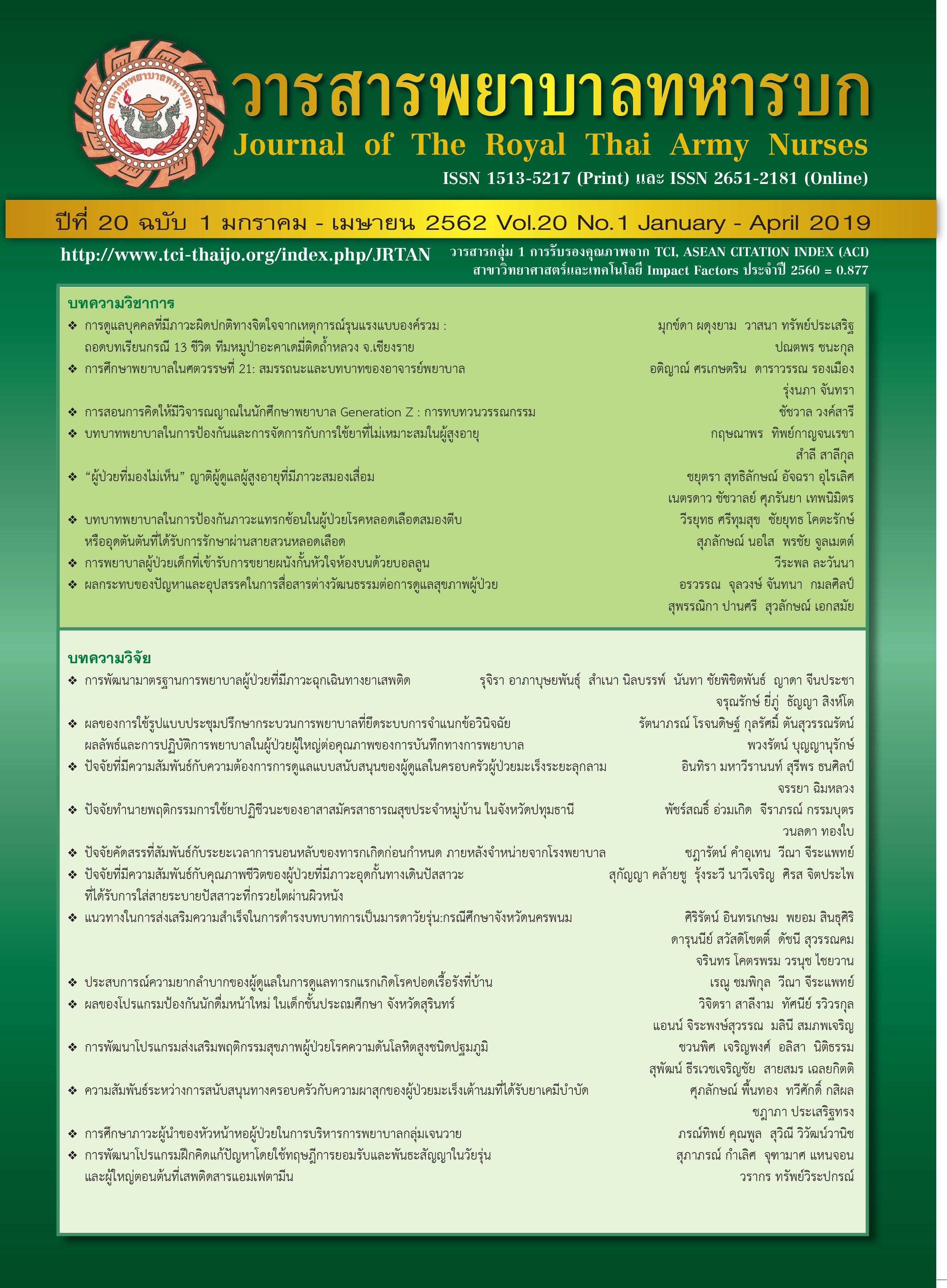Nurses’s Role to Prevent Complication in Ischemic Stroke Receiving Thrombectomy Treatment
Keywords:
Thrombectomy, Ischemic stroke, Nurse's roleAbstract
Treatment of patients with ischemic stroke through thrombectomy is another option beyond intravenous thrombolysis with recombinant tissue plasminogen activator (IV-rtPA) ipatients with large blood vessels occlusion or there are some contraindications to receiving IV-rtPA. However, such treatment methods have the potential to cause significant complications in patients such as neurological changes, intracerebral hemorrahge, or reocclusion after thrombectomy treatment including contrast-induced nephropathy etc. Nurses are important in the healthcare for taking care ischemic stroke after treating with thrombectomy. So, understanding of nursing care among pre-operative, intraoperative, and post-operative after thrombectomy treatment to prevent complications that may occur at various stages of treatment including when the patient returns to home.
Downloads
References
2. Bhatia R, Hill MD, Shobha N, et al. Low rates of acute recanalization with intravenous recombinant tissue plasminogen activator in ischemic stroke: real-world experience and a call for action. Stroke. 2010; 41: 2254-8.
3. Jüttler E, Schwab S, Schmiedek P, et al. Decompressive surgery for the treatment of malignant infarction of the middle cerebral artery (DESTINY): a randomized, controlled trial. Stroke. 2007; 38: 2518-25.
4. Worakijthamrongchai T. Endovascular treatment in acute ischemic stroke. Journal of Thai Stroke Society. 2017; 16: 5-13. (in Thai)
5. Broderick JP, Palesch YY, Demchuk AM, et al. Endovascular therapy after intravenous t-PA versus t-PA alone for stroke. New England Journal of Medicine. 2013; 368: 893-903.
6. Ciccone A, Valvassori L, Nichelatti M, et al. Endovascular treatment for acute ischemic stroke. New England Journal of Medicine. 2013;368: 904-13.
7. Berkhemer OA, Fransen PS, Beumer D, et al. A randomized trial of intraarterial treatment for acute ischemic stroke. New England Journal of Medicine. 2015; 372: 11-20.
8. Jovin TG, Chamorro A, Cobo E, et al. Thrombectomy within 8 hours after symptom onset in ischemic stroke. New England Journal of Medicine. 2015; 372: 2296-306.
9. Goyal M, Demchuk AM, Menon BK, et al. Randomized assessment of rapid endovascular treatment of ischemic stroke. New England Journal of Medicine. 2015; 372: 1019-30.
10. Campbell BC, Mitchell PJ, Kleinig TJ, et al. Endovascular therapy for ischemic stroke with perfusion-imaging selection. New England Journal of Medicine. 2015; 372: 1009-18.
11. Saver JL, Goyal M, Bonafe A, et al. Stent-retriever thrombectomy after intravenous t-PA vs. t-PA alone in stroke. New England Journal of Medicine. 2015; 372: 2285-95.
12. Wahlgren N, Moreira T, Michel P, et al. Mechanical thrombectomy in acute ischemic stroke: consensus statement by ESO-Karolinska stroke update 2014/2015, supported by ESO, ESMINT, ESNR and EAN. International Journal of Stroke. 2016; 11: 134-47.
13. Powers WJ, Derdeyn CP, Biller J, et al. 2015 American Heart Association/American Stroke Association focused update of the 2013 guidelines for the early management of patients with acute ischemic stroke regarding endovascular treatment: a guideline for healthcare professionals from the American Heart Association/American Stroke Association. Stroke. 2015; 46: 3020-35.
14. Nambiar V, Sohn SI, Almekhlafi MA, et al. CTA collateral status and response to recanalization in patients with acute ischemic stroke. American Journal of Neuroradiology. 2014;35: 884-90.
15. Jadhav AP, Molyneaux BJ, Hill MD, et al. Care of the post-thrombectomy patient. Stroke. 2018;49: 2801-7.
16. Forrow MG. in Prestigiacomo CJ. Endovascular surgical neuroradiology: theory and clinical practice. New York. 2014.
17. Sousa ID. Thrombectomy in acute ischaemic stroke and the implications for nursing practice. British Journal of Neuroscience Nursing. 2016;
12: S28-S31.
18. Prasat Neurological Institute. Nursing Guideline for Thrombectomy in Ischemic Stroke. Bangkok. (mimeohraphed)
19. Udomvisatsun R. Nursing care in patients with IV administration of contrast media. Songkla Medical Journal. 2004; 22: 415-424. (in Thai)
20. Poomsanguan K. Health empowerment: nurses’important role. Journal of The Royal Thai Army Nurses. 2014; 15: 86-90. (in Thai)
Downloads
Published
How to Cite
Issue
Section
License
บทความหรือข้อคิดเห็นใดใดที่ปรากฏในวารสารพยาบาลทหารบกเป็นวรรณกรรมของผู้เขียน ซึ่งบรรณาธิการหรือสมาคมพยาบาลทหารบก ไม่จำเป็นต้องเห็นด้วย
บทความที่ได้รับการตีพิมพ์เป็นลิขสิทธิ์ของวารสารพยาบาลทหารบก
The ideas and opinions expressed in the Journal of The Royal Thai Army Nurses are those of the authors and not necessarily those
of the editor or Royal Thai Army Nurses Association.






